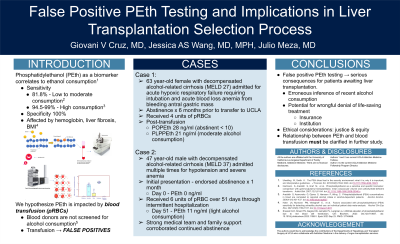(59) False Positive PEth Testing and Implications in Liver Transplantation Selection Process.
Saturday, April 6, 2024
9:45 AM - 1:15 PM

Has Audio

Giovani V. Cruz Cruz, MD
Addiction Medicine Fellow
UCLA, California
Jessica AS Wang, MD, MPH
Addiction Medicine Fellow
UCLA, California
Presenter(s)
Background & Introduction: Phosphatidylethanol (PEth) is a biomarker for ethanol exposure that is commonly used to assess for chronic alcohol consumption, particularly in patients undergoing liver transplant evaluation. PEth correlates strongly (Spearman’s 0.57 to 0.69) with the amount of alcohol consumed in the previous 30 days (Ulwelling et al). PEth is highly sensitive for high alcohol consumption (94.5% - 99%) as well as moderate to low consumption (81.8%), with a specificity of 100% (Arratodottir et al, Hartmann et al). Despite its high specificity and sensitivity, PEth may be altered by hemoglobin levels, liver fibrosis, and body mass index. (Hahn et al). Because of these features, PEth testing is widely used at our busy transplant center as a biomarker for abstinence from alcohol, and positive Peth results may have serious consequences such as deferral from transplant listing. However, our team has noticed transfusion of packed red blood cells (pRBCs) may lead to false positive results. Transfusion influences measured PEth concentrations, as blood donors are not screened for alcohol consumption. (Snoznek et al). Here we present two cases of presumed false positive PEth in the setting of recent pRBC transfusion in patients abstaining from alcohol use undergoing evaluation for liver transplant.
Case Description: Case 1: A 63-year-old woman with a past medical history of alcoholic cirrhosis (Model for End Stage Liver Disease, MELD, of 27), sober for the past 6 months, presented for decompensated cirrhosis and acute kidney injury due to hepatorenal syndrome (HRS). She required intubation for hypoxic respiratory failure and developed acute anemia secondary to an antral gastric mass requiring total of 4 units of pRBCs. She was transferred to a quaternary care center for liver transplant evaluation where POPEth was 28 ng/ml (normal < 10ng/dl) and PLPPEth was 21 ng/dl, consistent with moderate alcohol consumption. (Luginbuhl et al).
Case 2: A 47-year-old man with a past medical history of decompensated alcoholic cirrhosis (MELD 37), was admitted multiples times over a period of 2 months for hypotension and severe anemia. Initial PEth drawn was negative, and the patient had endorsed sobriety over the prior month. He was transfused a total of 6 Units of pRBCs which were given 1, 19, 33, and 51 days after initial PEth. After last transfusion, on day 51, patient was transferred to quarternary care center for liver transplant evaluation, and PEth was elevated to 11 ng/ml (normal < 10ng/ml) suggesting light alcohol consumption, despite abstinence for 2 months, corroborated by patient, medical chart, and family members.
Conclusion & Discussion: False positive PEth testing can have serious consequences for severely ill patients awaiting liver transplantation. As blood transfusion is not an uncommon requirement for this patient population, we must better understand the relationship between transfusion of allogenic packed RBCs and PEth lab values, especially if transplant committees are to continue placing significant weight on these numbers in the transplant selection process. This and other reasons for false positive PEth values as a biomarker for alcohol use warrant further study.
References: Ulwelling W, Smith K. The PEth blood test in the security environment: what it is; why it is important; and interpretative guidelines. J Forensic Sci. 2018;63(6):1634-1640. doi:10.1111/1556-4029.13874
Aradottir S, Asanovska G, Gjerss S, Hansson P, Alling C. Phosphatidylethanol (PEth) concentrations in blood are correlated to reported alcohol intake in alcohol-dependent patients. Alcohol Alcohol. 2006;41(4):431-437. doi:10.1093/alcalc/agl027
Hartmann S, Aradottir S, Graf M, et al. Phosphatidylethanol as a sensitive and specific biomarker: comparison with gamma-glutamyl transpeptidase, mean corpuscular volume and carbohydrate-deficient transferrin. Addict Biol. 2007;12(1):81-84. doi:10.1111/j.1369-1600.2006.00040.x
Hahn JA, Murnane PM, Vittinghoff E, et al. Factors associated with phosphatidylethanol (PEth) sensitivity for detecting unhealthy alcohol use: an individual patient data meta-analysis. Alcohol Clin Exp Res. 2021;45(6):1166-1187. doi:10.1111/acer.14611
Snozek CLH, Kinard TN, Alegria KN, Jannetto PJ, Langman LJ. Artificial elevation of phosphatidylethanol due to red blood cell transfusion. Clin Biochem. 2023 Oct;120:110651. doi: 10.1016/j.clinbiochem.2023.110651. Epub 2023 Sep 23. PMID: 37748668.
Case Description: Case 1: A 63-year-old woman with a past medical history of alcoholic cirrhosis (Model for End Stage Liver Disease, MELD, of 27), sober for the past 6 months, presented for decompensated cirrhosis and acute kidney injury due to hepatorenal syndrome (HRS). She required intubation for hypoxic respiratory failure and developed acute anemia secondary to an antral gastric mass requiring total of 4 units of pRBCs. She was transferred to a quaternary care center for liver transplant evaluation where POPEth was 28 ng/ml (normal < 10ng/dl) and PLPPEth was 21 ng/dl, consistent with moderate alcohol consumption. (Luginbuhl et al).
Case 2: A 47-year-old man with a past medical history of decompensated alcoholic cirrhosis (MELD 37), was admitted multiples times over a period of 2 months for hypotension and severe anemia. Initial PEth drawn was negative, and the patient had endorsed sobriety over the prior month. He was transfused a total of 6 Units of pRBCs which were given 1, 19, 33, and 51 days after initial PEth. After last transfusion, on day 51, patient was transferred to quarternary care center for liver transplant evaluation, and PEth was elevated to 11 ng/ml (normal < 10ng/ml) suggesting light alcohol consumption, despite abstinence for 2 months, corroborated by patient, medical chart, and family members.
Conclusion & Discussion: False positive PEth testing can have serious consequences for severely ill patients awaiting liver transplantation. As blood transfusion is not an uncommon requirement for this patient population, we must better understand the relationship between transfusion of allogenic packed RBCs and PEth lab values, especially if transplant committees are to continue placing significant weight on these numbers in the transplant selection process. This and other reasons for false positive PEth values as a biomarker for alcohol use warrant further study.
References: Ulwelling W, Smith K. The PEth blood test in the security environment: what it is; why it is important; and interpretative guidelines. J Forensic Sci. 2018;63(6):1634-1640. doi:10.1111/1556-4029.13874
Aradottir S, Asanovska G, Gjerss S, Hansson P, Alling C. Phosphatidylethanol (PEth) concentrations in blood are correlated to reported alcohol intake in alcohol-dependent patients. Alcohol Alcohol. 2006;41(4):431-437. doi:10.1093/alcalc/agl027
Hartmann S, Aradottir S, Graf M, et al. Phosphatidylethanol as a sensitive and specific biomarker: comparison with gamma-glutamyl transpeptidase, mean corpuscular volume and carbohydrate-deficient transferrin. Addict Biol. 2007;12(1):81-84. doi:10.1111/j.1369-1600.2006.00040.x
Hahn JA, Murnane PM, Vittinghoff E, et al. Factors associated with phosphatidylethanol (PEth) sensitivity for detecting unhealthy alcohol use: an individual patient data meta-analysis. Alcohol Clin Exp Res. 2021;45(6):1166-1187. doi:10.1111/acer.14611
Snozek CLH, Kinard TN, Alegria KN, Jannetto PJ, Langman LJ. Artificial elevation of phosphatidylethanol due to red blood cell transfusion. Clin Biochem. 2023 Oct;120:110651. doi: 10.1016/j.clinbiochem.2023.110651. Epub 2023 Sep 23. PMID: 37748668.
Learning Objectives:
- Discuss the implications of PEth results, especially in the context of liver transplant evaluation.
- Explore how transfusion of packed red blood cells (pRBCs) may lead to false-positive PEth results.
- Recognize the unique challenges faced by patients with alcohol use disorders, many of whom belong to racial and ethnic minorities.
